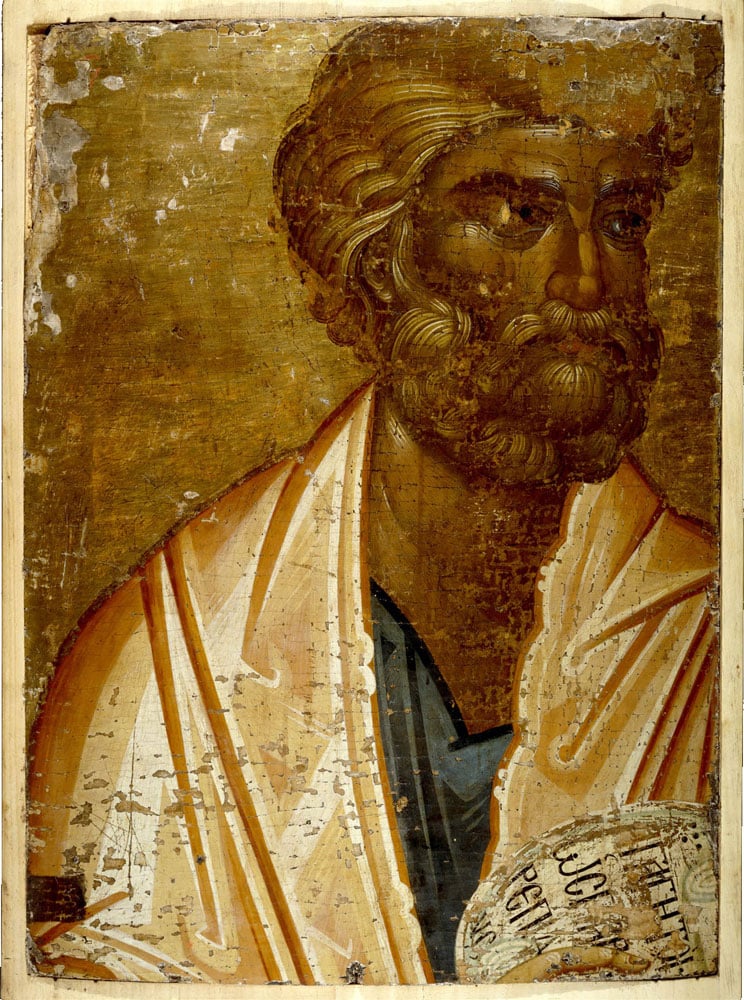The icon is painted in egg tempera with gold leaf on a cedar wood panel primed with gesso over a coarse tabby linen. It represents a saint with a scroll, who can be identified as St Peter, set against a gold ground. The half-figure of the bearded apostle is shown looking to our right. He is dressed in a greyish blue tunic and an apricot tint pallium. The style is reminiscent of fresco painting rather than of icons. He holds an open scroll in his right hand; the scroll is white, inscribed in Greek letters in black: ΑΓΑΠΗΤΟΙ ωC ΠΑΡ ΡΕΠΙΔ C (Αγαπητοί [παρκαλω] ως π[αροίκους και πα] ρεπιδ [ήμους απέχεσθαι των σαρκικων έπιθυμιων αιτινες στρατεύονται κατα της ψυχη]ς; ‘Dearly beloved, I beseech you as strangers and pilgrims, to refrain yourselves from carnal desires which war against the soul’). The halo is defined by two concentric arcs inscribed into the gold background.
The panel has been cut down on all sides from its original size, and the bust is off-centre. Only part of one hand is visible. The nose has been restored, and the top of the head is damaged. An uncleaned patch has been left near the bottom of the left-hand side. The panel has been damaged by woodworm, and the paint surface has suffered some abrasion. It is important to realise that the nose as it is now has been restored and that when it was being restored the paint in this area had been lost, and the restorer made a creative guess about the nature of the original nose. The back looks fresh as it is actually the result of slicing the original panel in two vertically.
St Peter is set against a gold ground. The identification derives from consideration of the portrait type and the fact that the text which he holds is taken from the First Epistle of Peter. It seems probable that St Peter was originally shown in half-figure length. The Greek text on the scroll is from 1 Peter 2: 11, and the choice of this text would seem most suitable for a monastery setting. Considering the size of the icon, it can be suggested that it was designed to fit into a church sanctuary screen. From the 13th century, there is evidence that the Middle Byzantine templon screen began to be filled with intercolumnar icons, marking the beginning of the transition of the sanctuary screen into the full blown and opaque Late Byzantine iconostasis. In the early church the laity in the nave could see directly into the sanctuary with the altar. With the development of the templon screen, the sanctuary could be hidden behind curtains or icons set between the columns of the templon. By the Late Byzantine period, the sanctuary was totally hidden from the laity behind the tall iconostasis, and the altar could be made visible to the congregation at the dramatic moments of the liturgy by opening the central so-called “royal doors”. The icon of St Peter is probably one of the first icons to have been fitted into the new type of the iconostasis, where icons hid the sanctuary from the gaze of the congregation, who instead looked at the array of icons on the screen which separated them from the altar.
The proposed dating of the icon of St Peter to around 1320 was made from a comparison with the wall paintings and mosaics of the Chora monastery in Constantinople, now known as the Kariye Camii. This church dates from between 1315 and 1321, and the artists who worked there were probably previously employed to produce the mosaics of the Church of the Holy Apostles in Thessaloniki (accepting a date for this decoration as 1312–4). One speculation is that one of the artists who worked at the Chora church was the painter of the British Museum icon of St Peter.
Literature: S. Mihalarias and R. Cormack, A Major New Discovery. The Icon of Saint Peter by the Master of the Monastery of Chora, (Barbican Centre, London, 25 April–19 June, 1983), and a version also in Zygos 2 (1983), 130ff.; K. Weitzmann, The St Peter Icon of Dumbarton Oaks, Washington D.C., 1983, 17, fig 13; A. Acheimastou-Potamianou (ed.), From Byzantium to El Greco. Greek Frescoes and Icons (exh. cat., Royal Academy of Arts), Athens, 1987, no. 16, 156–7; M. Cheremeteff, ‘The Transformation of the Russian sanctuary barrier and the role of Theophanes the Greek’, in A. Leong, The Millenium: Christianity and Russia 988–1988, New York, 1990, 107–40; D. Buckton, Byzantium: Treasures of Byzantine Art and Culture from British Collections (exh. cat., The British Museum), London, 1994, no. 222, 205–6; H. C. Evans (ed.), Byzantium. Faith and Power (1261–1557) (exh. cat., The Metropolitan Museum), New York, 2004, no. 112, 92–3; R. Cormack, Icons, London, 2007 (repr. 2014), 42–5, 114, no. 7.
Robin Cormack
